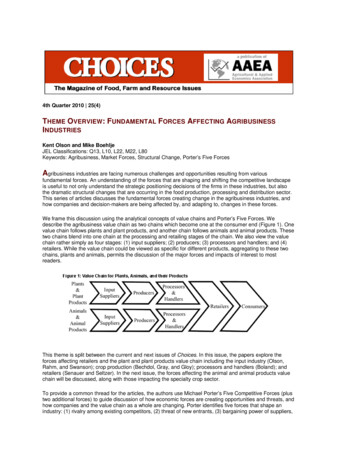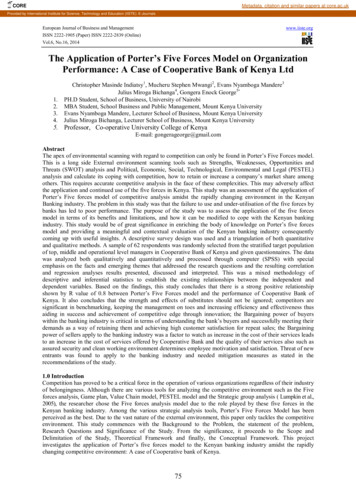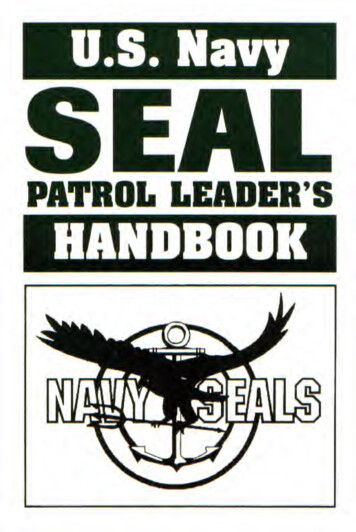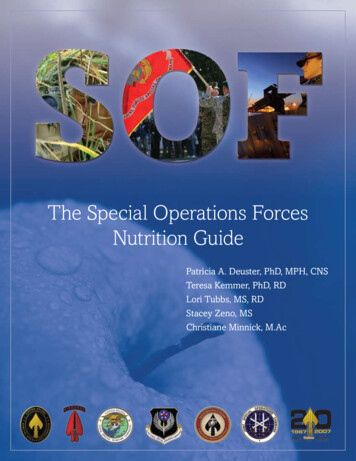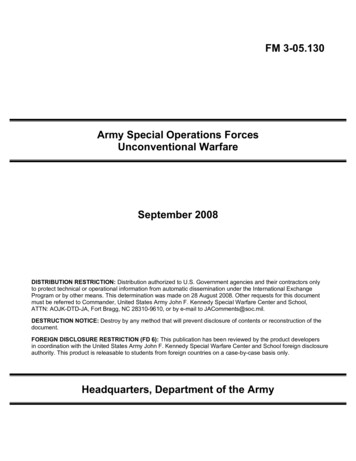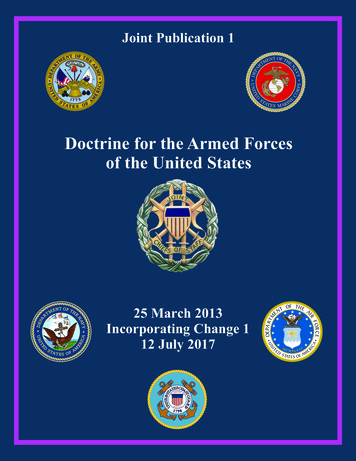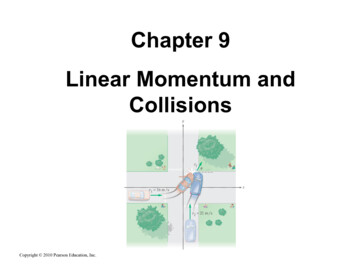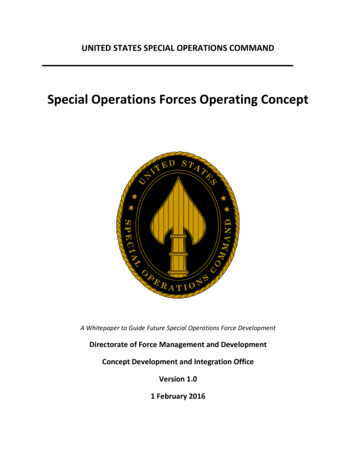
Transcription
UNITED STATES SPECIAL OPERATIONS COMMANDSpecial Operations Forces Operating ConceptA Whitepaper to Guide Future Special Operations Force DevelopmentDirectorate of Force Management and DevelopmentConcept Development and Integration OfficeVersion 1.01 February 2016
COMMANDER’S FOREWORDThe Special Operations Forces (SOF) Operating Concept (OC) describes in broad terms theframework for how SOF will operate in the future. Nested with the Chairman’s CapstoneConcept for Joint Operations – Globally Integrated Operations and informed by current strategicguidance, it addresses the challenges SOF will face in the future. The purpose of this documentis to influence force development and wargaming by establishing an overarching construct forSOF operations in a demanding future environment.SOF will always provide critical capabilities to resolve crises and support major operations;however, our success in the future environment will be determined by our ability to navigateconflicts that fall outside traditional peace-or-war constructs. SOF’s greatest value to theNation, and consequently the primary idea of this concept, lies in our global perspective,coupled with the ability to act early with partners to provide a range of options for policymakers. Operating ahead of crisis allows SOF and partners to develop long-term and costeffective options to prevent or mitigate conflict.To create decision space and strategic options for Geographic Combatant Commanders andNational leadership, SOF will execute Integrated Campaigning with partners. This conceptexpands the construct of a “campaign” from a series of related major military operations to aseries of integrated activities executed with a growing list of partners. Future campaign plansmust be deliberately designed to synchronize whole of government approaches. Whetherproviding a supporting role, or in the lead, SOF will utilize an Integrated Campaigning approachto coordinate participation and support from partners to achieve US policy objectives.USSOCOM’s contributions to successful Integrated Campaigning will be enabled by optimizingour SOF operators, enhancing SOF unity of effort, and maximizing the development andsustainment of purposeful partnerships. Expanding these capabilities will require bothoperational and institutional changes. The Enterprise will need to develop doctrine thatdescribes new methods for integrating our actions, both internally and with our partners. Itmust also change how we select, educate, train, equip, and manage our people. This concept isdesigned to act as a catalyst for these changes.This document is more than a vision; it is an actionable framework to improve future SOFreadiness and further capability development to ensure we have the right force in the rightplace with the right tools at the right time.
1. IntroductionAgility and flexibility are the foundational strengths that allow Special Operations Forces (SOF)to rapidly seize opportunities and adapt to unforeseen requirements and operationalchallenges. Facing a complex and uncertain future, the Nation expects SOF to apply thesestrengths to more fully integrate with partners and better identify and develop strategicopportunities to advance and protect US interests.In an increasingly interconnected world, a broadening array of state and non-state actorsemploying irregular and hybrid approaches challenge US interests. Identifying activities andintentions of these malign actors within disordered societies and disenfranchised populations ischallenging, but not impossible. To achieve this, persistent operations and deep understandingof the human domain will be necessary to identify and influence relevant actors to produceoutcomes acceptable to the US.The risk of not acting, or acting late, can dramatically alter the world landscape, eroding theNation’s security, influence, and standing while allowing nefarious actors to inflict horrifichuman catastrophe as demonstrated by ISIS in Iraq and Syria. Limited and reactionaryresponses are the result of insufficient awareness and understanding of emerging indicators ofinstability.SOF will always provide critical capabilities to resolve crises and support major operations.However, SOF’s value to the Nation lies in our global perspective, coupled with the ability to actearly with partners to provide a range of options for policy makers. Operating ahead of crisisallows SOF and partners to develop long-term and cost-effective options to prevent or mitigateconflict, providing decision space and strategic options to achieve outcomes favorable to theUS.12. Future Operating EnvironmentThe future operating environment will be characterized by an increasingly complex set ofchallenges in every part of the world – from the destabilizing influence of state aggression, tothe expansion of radical networks across regions, to the growing threat of ubiquitousinformation warfare.2 These threats will be increasingly transnational, trans-regional, and multidomain and cannot be addressed in isolation. This era of extraordinary security challenges hasbeen described as “the age of everything,” an age where commanders must meet the highdemand for all types of missions and threats.31Within this document, the term “partner” refers to organizations or actors with similar and intersecting interestsand values.2The future environment is more fully described in USSOCOM’s Strategic Appreciation and USSOCOM 2035.3Ashton B. Carter, Maintaining the Edge in the Age of Everything, 02NOV15; Bradley Peniston, Work: “The Age ofEverything Is the Era of Grand Strategy,” NOV15.1
The spread of technology into an increasing number of cultures and societies is driving changein the strategic environment. Easier access to information is permitting the diffusion of powerand influence to a broader range of actors, state and non-state, who have not traditionallywielded it. Adversaries can now easily access tools that range from advanced weapon systemsand cyber capabilities to improvised explosive devices, all of which provide an expandingvariety of coercive options at their disposal. Populations, enabled by advances incommunications, are increasingly challenging the legitimacy of their governments anddemanding change on a range of issues. Governments unwilling or unable to accommodatechange will face increasing pressure from segments of their populations.Beyond the employment of improved technology, adversaries will continue to blend traditionaland irregular techniques, capabilities, and resources to execute hybrid approaches in the grayzone4, the space between peaceful competition and war. Actors will seek to advance theirinterests by exploiting local grievances, existing instabilities, weak governments, and culturalseams while avoiding America’s conventional military dominance. As a result, SOF willincreasingly be confronted with uncertainty and doubt regarding the nature of crises andconflicts, the parties involved, and the validity of the legal and political claims at stake.While hybrid and irregular approaches continue to expand, traditional war remains a real andcostly possibility. Hybrid approaches by state actors could rapidly generate unintendedconsequences and spiral into major conflict with threatened state, or non-state stakeholders.Future trends will require SOF to more deeply understand the operating environment anddevelop capabilities to act earlier. SOF, as part of the Joint, Interagency, Intergovernmental andMultinational (JIIM) network, must be increasingly flexible, agile, and capable of integratingoperations across national and Geographic Combatant Command (GCC) seams to effectivelyneutralize threats to US interests.3. Operational ChallengeHow will Special Operations Forces conduct and support operations to prevent strategicsurprise and counter adversary actions that frustrate US strategic objectives?The operational challenge requires SOF to adapt to the future operating environment. SOF willbe required to develop a deeper understanding of the environment to see and act ahead offlashpoints of instability, inform the development of US options, and reduce operational andstrategic blind spots.4USSOCOM White Paper The Gray Zone, 09SEP152
4. Central IdeaSOF will act early, persistently, and precisely to create decision space and strategic options forGeographic Combatant Commanders and National leadership to achieve sustainableoutcomes favorable to US National interests.SOF must already be in place around the globe, integrated with an evolving community ofpartners, to identify subtle changes in environments and understand the significance of thosechanges. Early detection enables leadership to make informed decisions, exploit opportunities,and employ appropriate preventative measures. This process creates the strategic spacenecessary for our Nation to develop and implement effective policy.The application of SOF capabilities alone will not achieve policy objectives. They are achieved bythe integration of JIIM partners’ capabilities focused toward shared objectives and commongoals. Understanding this, SOF will execute Integrated Campaigning as part of a larger JIIMteam to achieve the Central Idea of this concept.Integrated CampaigningCampaigns will become more diverse and sophisticated, and the idea of a campaign will expandfrom a series of related major military operations to a series of integrated JIIM activities toachieve operational and strategic objectives. Campaign plans will be deliberately designed tosynchronize whole of government approaches to ensure the most effective capabilities areapplied to problem sets regardless of the agencies in which they reside. Campaign plans will beused to coordinate participation and support from partners when the US is in the lead, or willbe developed to support partner-led campaigns.Within and across multiple campaigns, SOF activities spanning the range of military operationswill occur simultaneously. Campaigns will be problem focused and organized regionally ortrans-regionally as appropriate. They will be layered globally and may intersect based on theactors, problems, or geography. Close coordination to synchronize effects will be accomplishedthrough interconnected networks of partners executing and supporting operations. Campaignswill be led by a Joint Task Force, an interagency organization, partner nation, or by SOFdepending on the scope and scale of the campaign.Integrated campaigns may last for decades, requiring strategic patience, as the will of theadversary and root causes of confrontation are not easily reversed. Within the emergingoperational environment, success will be defined by the preservation of US and allies’ interestswithout escalation to major operations.SOF will support or lead campaigns to counter irregular and hybrid approaches employed byadversaries, often occurring in the gray zone. SOF success in these campaigns will be enabled by3
operators’ and units’ deep understanding of environments, regions and populations, andestablishing and sustaining critical relationships with key powerbrokers.To develop a better understanding of the human domain in regional and localized communities,SOF will expand its investment in cultural and language education for select forces. However,deep understanding, situational awareness and the ability to influence relevant actors will onlybe achieved through relentless physical and virtual presence in targeted areas. SOF will achievepersistent presence by conducting continual activities, both overtly and clandestinely, in areasprioritized by location of partners, adversary activity, and populations at risk.The deep understanding derived by operators from these activities, coupled with US CountryTeam5 and other partners’ understanding, will help identify inflection points of instabilitybefore they expand to tactical, operational, or strategic challenges. Early detection will enablemore targeted and timely responses and provide policy makers increased options and the timeand space for planning, decisions, and approvals.SOF roles will vary by campaign, but they will normally support the development and executionof the campaign’s human objectives, those actions taken to influence actors relevant to theproblem. Activities to counter adversary irregular and hybrid approaches will span SOF coreactivites and could range from Military Information Support Operations to precise and discreetapplication of SOF’s robust strike capability.6SOF will also be a critical component of US Support to Resistance7 (STR) efforts. STR, thecoordinated application of all instruments of US National power to enable a resistancemovement, includes activities ranging from political support, to the provision of non-lethal andlethal aid, to the conduct of unconventional warfare. STR allows the US to counter regular,irregular and hybrid threats without a direct confrontation with an adversary, reducing orprecluding the need to commit US military forces on a large scale. STR activities seek toempower legitimate local actors who can communicate a compelling narrative, mobilizesupporters, and restore stability primarily with local forces and resources.At the strategic level, USSOCOM’s Combatant Command authority of Special Operations Forceswithin each GCC area of responsibility (AOR) uniquely postures it to support the GCCs,Department of Defense, and the interagency with the development and integration of transregional priorities and campaigns. Executing these campaigns will ensure trans-regional5A US Country Team is the senior, in-country, United States coordinating and supervising body, headed by thechief of the United States diplomatic mission, and composed of the senior member of each represented UnitedStates department or agency, as desired by the chief of the United States diplomatic mission. Source: JP 3-07.46Comprehensive list of SOF Core Activities can be found in JP 3-05, Special Operations.7From the USSOCOM, Support to Resistance white paper, “Building the Case for a US Government Guide,” 22October 2015.4
priorities are not subsumed by regional priorities and drive the synchronization of strategicplans to the tactical level.Based on its ability to see regionally and trans-regionally, USSOCOM will use a layered approachto synchronize SOF efforts and effects with various partners through the Theater SpecialOperations Commands (TSOCs) and GCCs. SOF may conduct activities against a state or nonstate actor, or their proxies, in one GCC AOR to achieve an effect on that same actor located inanother GCC’s AOR. Increasing pressure applied in one area will allow SOF, or partners withdiffering perspectives or deeper regional understanding, to detect instability in other areas.This will support broader opportunities across multiple networks, and greater effectivenessacross multiple, integrated campaigns.Should the US be unable to deter, limit, or defeat malign actors, or should an adversary commitan act so egregious as to be unacceptable to the US or its allies, SOF will always be prepared tosupport major operations. The return on investment from Integrated Campaigning is thereduced frequency, scale, scope, and duration of hostilities. Deep understanding of a regionand its human domain, and relationships with relevant actors will be leveraged in conjunctionwith unified JIIM action to terminate conflict and restore stability, faster and at a lower cost,than had no prior action been taken.Integrated Campaigning will create decision space and strategic options for policy makers byidentifying and developing opportunities with partners, detecting inflection points of instability,and deterring adversaries. Acting early, persistently, and precisely will reduce, but not eliminaterisk. Although tactical risk may rise during the conduct of simultaneous campaigns, the strategicrisk of inaction will increase exponentially over time, along with the ultimate cost of resolution.SOF support to and execution of successful Integrated Campaigning will be achieved throughoptimizing the use of SOF operators, enhancing SOF unity of effort by more effectively blendingforces and capabilities, and maximizing the development and sustainment of purposefulpartnerships.Enabled SOF OperatorsThe first SOF Truth, Humans are more important than hardware, remains the cornerstone belieffor USSOCOM. SOF’s success is dependent on the agility and flexibility of its enabled SOFoperators. USSOCOM will implement the Future Special Operator Concept to ensure theEnterprise8 can place the right operators in the right place, at the right time, and with the righttraining and education to enhance SOF’s future success.8For the purpose of this paper, the SOF Enterprise includes US and partner nation SOF, and those structures whichsupport special operations, including the NATO SOF Headquarters, partner nation USSOCOM-like headquarters,and other government agencies.5
To meet the challenges of the future operating environment, USSOCOM will recruit, select,develop, and manage a more diverse force. USSOCOM will support nontraditional careerpatterns, educate and train innovative and adaptive leaders, and continually align institutionaleducation and training programs with changes in the operational environment. USSOCOM willenable SOF operators’ freedom of action by defeating biometric technology, minimizingdetection through social media, enhancing deception measures, providing robust intelligencesupport, and expanding nonstandard logistics.USSOCOM will enable its operators to be more agile by developing and rapidly injecting thelatest technology into SOF units, leveraging the cyber domain to deliver precise effects insupport of SOF objectives. SOF will also continue to explore innovative means to improveoverall performance, survivability and rehabilitation of its operators. This will include exploitingadvances in human-machine interface, remote health monitoring, enhancement of individualphysical capabilities, increased individual lethality, robotics, and neural implants andprostheses.Strategic thinking, discovery, and opportunity development will be encouraged at every level.SOF will pulse operational units and seasoned operators for feedback when framing anddesigning campaigns. SOF operators will also be encouraged to innovate, question, andchallenge assumptions and processes to inform the chain of command with findings andanalysis at the point of action, providing valuable insight into ambiguous and rapidly changingenvironments.The key to USSOCOM’s future success lies in continued investment in and advancement of aSOF talent development and management system. The ultimate measure of success will beeffective operations by enabled SOF operators who can navigate complex and uncertain futureoperating environments.SOF Unity of EffortSOF will increasingly think, organize critical capabilities, and fight as one team, with divisionsbetween National Mission Force (NMF) and Theater SOF becoming significantly less distinct.SOF will blend forces from across the Enterprise with the requisite capabilities into coherentforce packages to exploit opportunities and challenges.Increased integration of NMF and Theater SOF will provide a distinct advantage to TSOC andGCC campaigns by enhancing their ability to achieve desired effects and will present a moreunified SOF team to partners. Integrating the complementary capabilities of National andTheater SOF provides options to commanders and increases the effectiveness of SOF.Within campaigns, all SOF will be placed under a single special operations commander with therequisite command authorities to direct all forces employed in pursuit of a common purpose.6
The establishment of a single SOF operational command per campaign will optimize utilizationand effectiveness of SOF enablers across formations and priorities, increase coordination, andensure complementary effects within SOF and within the broader GCC or trans-regionalcampaigns’ command and control architecture.Purposeful PartnershipsSOF must continue to identify, develop, and sustain purposeful partnerships to enablesuccessful Integrated Campaigning. Partnerships reduce response time, extend reach intodenied territory, and foster more creative design options for problem solving.Purposeful partnerships allow SOF to better understand the human domain and complexoperating environments. Partnerships reduce SOF cultural and conceptual gaps and provideexpanded, penetrative, and diverse information and intelligence networks. These networks arecritical to identifying precursors of instability before they reach tipping points.To achieve greater collective JIIM agility and flexibility, SOF will formally embed and exchangeliaison elements with an evolving list of partners to achieve an unprecedented degree ofunderstanding and capability for integrated action. SOF will modify organizations to ensure thateach liaison element is properly structured and manned by SOF personnel with the educationand experience to be valuable, productive contributors to partner organizations whileadvancing and protecting US interests globally.5. ConclusionSOF must expand and enhance its value to the Nation by operating ahead of crises to preventstrategic surprise and deter, disrupt, or defeat adversary hybrid and irregular approaches in thegray zone, precluding the need for large-scale deployment of military forces. Empowered byenabled SOF operators, fueled by SOF unity of effort, and aided by purposeful partnerships, SOFwill support and conduct Integrated Campaigning to provide National leadership with decisionspace and options to protect US security interests globally.Appendices:A – Required Capabilities7
Appendix A – Required CapabilitiesThe SOF Operating Concept required capabilities are derived from the elements of the CentralIdea. These required capabilities are inter-related and mutually supporting. This Appendixrepresents the start point for future Special Operations Forces capability development acrossthe Enterprise to prepare the force to adapt to and succeed in the future operatingenvironment.1. Integrated Campaigning. The following capabilities will enable SOF’s ability to plan, supportand conduct Integrated Campaigning to meet the challenges of the future.The ability to holistically understand and counter irregular and hybrid warfare andapproaches increasingly used by competitors, adversaries and enemies to advance interestsand frustrate US objectives. Proficiency in developing greater understanding of competitor and adversary irregular,and hybrid approaches to better design, plan, and coordinate effective and efficient SOFprevention and deterrence measures, and responses.Proficiency of SOF organizations to more effectively and efficiently plan, coordinate andexecute SOF missions supporting Integrated Campaigning with partners, to prevent,deter, and counter competitor and adversary hybrid approaches.Proficiency for SOF operators to conduct cyber-enabled SOF operations to influenceforeign audiences and reduce the risk to the force and gain advantage over competitors,adversaries, and enemies.Sufficiency of mobility platforms to infiltrate and operate in denied spaces in small teamswith low-signature (clandestinely) to support partners, gain situational understanding,provide early warning of crisis/conflict, and counter state and non-state hybrid andirregular threats.The ability to enable, plan and execute trans-regional approaches that support IntegratedCampaigning and provide broader options to US decision makers. Sufficient authorities and permissions to prepare the environment – develop theopportunities and options through the collection and dissemination of information andintelligence, and development of virtual, physical, and human infrastructure as a hedgeagainst potential challenges and threats.Sufficient staff with the proficiency to analyze and assess the environment, plan andsupport activities and campaigns, and coordinate with partners (i.e. state, non-state,civilian and military).8
Proficiency to understand the disposition and intention of trans-regional networks, andthe characteristics and conditions of the global strategic environment that affectNational and military decision making.Sufficiency to collect, store, retrieve, analyze, and disseminate data on SOF andadversary activities in each geographic region to gain broader understanding of threatsto instability and develop, coordinate, and synchronize trans-regional options.The ability to sustain persistent engagement globally to advance and protect US Nationalinterests. Sustainable forward posture (forces, footprint, and agreements) in foreign countries toestablish and maintain critical relations, develop and sustain critical partnerships, andsupport building partner capabilities and capacities.Proficiency and sufficiency to understand and operate in the human domain.The ability to generate and leverage conventional and nonstandard logistics support globallyto enable rapid and flexible SOF response and sustainment across the range of militaryoperations. The capacities and flexibility to support and sustain SOF operations globally, in multipletheaters, from days to years, using standard and nonstandard capabilities, andleveraging partner capabilities.The proficiency and resources to leverage Service, Joint, Interagency, Multinational andcommercial support; and to develop SOF organic logistics capabilities as required tosustain and support small-footprint, global, and disaggregated operations.The authorities, permissions, and abilities to employ nonstandard logistics andcommunications capabilities to support operations in denied and politically sensitiveareas to operate undetected in an increasingly transparent operating environment.The ability to employ precision capabilities (Hostage Rescue and Recovery (HRR), CounteringWeapons of Mass Destruction (CWMD), and Counterterrorism (CT)) globally, at any time,under all conditions, to protect the force, prevent instability, and eliminate threats to theNation. The sufficiency to execute HRR, CWMD, and CT globally, at any time, under allconditions, unilaterally and with partners, to eliminate threats to the Nation.The sufficiency in resources to support training, equipment, and technologies to supportHRR, CWMD, and CT mission readiness.Sufficiency of authorities, permissions, and abilities to operate using indigenous systemsfor communications, surveillance, reconnaissance, and logistics to operate undetected inan increasingly transparent operating environment.9
2. Enabled SOF Operators. SOF’s success is dependent on the agility and flexibility of itsenabled SOF operators. Integrated Campaigning is predicated on, and empowered by, SOF’sunique value to the Joint Force, USG, and allies and partners. That value is first and foremostdetermined by enabled SOF operators.The ability to recruit, select, develop, and enable SOF operators to act ahead of crises. Capability to support irregular career patterns and manage SOF careers to meet thechallenges of the future operating environment.Expand capacity to improve overall human performance, survivability, and rehabilitationof its operators.Proficiency to routinely understand and leverage communications capabilities throughcommercial networks, and corresponding social-media analysis, as a force protectionmeasure to monitor potential adversary communications and operations.3. SOF Unity of Effort. SOF unity of effort will be increased by blending NMF and Theater SOFto provide GCCs, USG, and partners with full-spectrum SOF capability as part of IntegratedCampaigning. Central to this capability is thinking, organizing, and fighting as one SOF teamwith more coherent force packages to exploit opportunities and challenges.The ability to more effectively blend forces from across the Enterprise with the requisitecapabilities into coherent force packages to exploit opportunities and challenges. Sufficiency of SOF doctrine to enable increasingly effective integration of NMF andTheater SOF.Sufficiency of training venues and resources to enable more effective integration ofNMF and Theater SOF.Proficiency of SOF HQs elements to C2 and Mission Command diverse, integrated SOFcapabilities.4. Purposeful Partnerships. SOF alone cannot advance and protect US National interests, norplan, coordinate, support, and conduct Integrated Campaigning. Purposeful, evolving, andsustained partnerships are critical to SOF’s agility and flexibility.The ability to influence indigenous actors, groups, and populations to identify, develop, andsustain purposeful partnerships. Proficiency to more effectively influence the perceptions, will, and behaviors of relevantactors and populations to build effective, legitimate, interoperable, and self-sustainingpartners (tactical to strategic) to advance and protect mission and campaign objectives. Sufficiency of liaison elements to build trust and support sustained interaction withinteragency partners, allies, coalition partners, and non-governmental organizations.10
COMMANDER'S FOREWORD The Special Operations Forces (SOF) Operating Concept (OC) describes in broad terms the framework for how SOF will operate in the future. Nested with the hairman's Capstone Concept for Joint Operations - Globally Integrated Operations and informed by current strategic guidance, it addresses the challenges SOF will face in the future.

